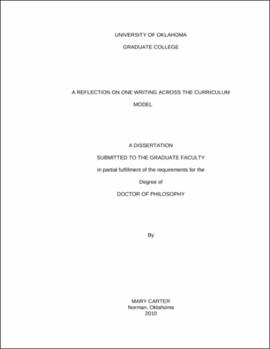| dc.description.abstract | This dissertation first looks at historical iterations of the primary form of first and second WAC implementation, the workshop model. It is necessary to first situate WAC models in their respective institutions and then assess if strategies used in other contexts represented a "best fit," so different modes of workshop implementation will be examined as well. Integral to stimulating change is providing consistent support for WAC components; in smaller institutions, a tipping point of changing views across the institution may provide that support, but in a large research university, faculty are more insulated within their departments where attitudes may be slower to change. The one-to-one model has great potential to affect change in the area of faculty development in larger institutions. Continuing one-to-one support for faculty may be key to the lasting success the WAC program at large doctoral-granting universities. Drawing on many topics integral to the first-wave workshop setting, one-to-one WAC collaborations cover assignment design aspects, such as clarifying goals and objectives and developing criteria, classroom implementation, such as low-stakes writing, modeling exercises and peer review, and responding to student writing through a drafting process and using rubrics. Overall, the three WAC scenarios here represent a range of faculty attitudes toward the implementation of new pedagogical methods. Because of the depth of penetration achieved within a department, the tangible support provided to faculty, and prospects for long-term WAC sustainability, writing fellows paired with faculty on semester-long projects offer benefits in a large institutional setting that workshops cannot provide. The variables comprised by the participants in the collaborative relationship have the largest confounding effect on the results achieved; therefore very effort has been made to quantify skills needed to maintain this relationship. | |
